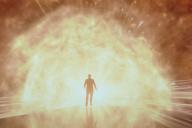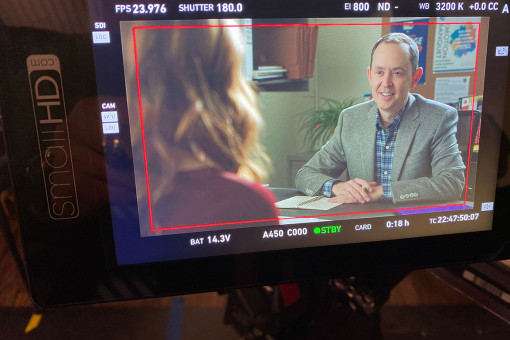It has been many years since world-famous astrophysicist Carl Sagan plucked an unsuspecting audience of PBS viewers off their couches and led them on a foray into the depths of the unexplored universe in Cosmos: a Personal Voyage.
For many, it was their first journey into unknown territory, where much is still left to the discovered.
Now, some two decades later, National Geographic plans to take those viewers out into the great unknown yet again in Cosmos: Possible Worlds. In some ways, the challenge is greater than it was 20 years ago. Imagining the furthest reaches of space in a time where visual effects are constantly evolving is a daunting task.
For VFX supervisior Jeffrey Okun, however, it was an opportunity well worth the challenge.
Jeffrey Okun: I'm a huge space nut. I would've been an astronaut if they'd let me.
"I'm a huge space nut," said Okun, "I would've been an astronaut if they'd let me. I was so excited to portray this stuff, but since it's a science-based show, and they gave me access to so many astrophysicists and scientists... it became the most energized, thrilling, educational environment that one could dream of."
Okun, who has served as visual effects supervisor on films such as The Last Samurai, The Day the Earth Stood Still, and Clash of the Titans, has had a plethora of experience to pull from in regards to visual effects.
However, when it came time to lay the groundwork for how Possible Worlds would depict the greater cosmos, Okun found his building blocks in the innovation of Sagan's original series.
"We did take from the original. Whenever I would get stymied and frustrated with my inability to take something to the next level, I found that going back and watching the original show... I found it enlightening," Okun said.
"In dealing with [executive producer Ann Druyan], I said, 'If Carl were with us right now, what do you think he'd let me do?'"
While the inspiration of Sagan's original work provided a solid foundation for the next installment in the Cosmos series, a lot has changed in the world of visual effects since the 1980s.
In order to bring the show (including some of Sagan's lesser-explored ideas) into the next generation, Okun and his team had to visually imagine a universe far more immense than what had come before, while still maintaining the spirit of the original.
"It's about being able to communicate complex concepts to everybody. When it fell to me, the question became, 'How can I do this in a way that is going to be exciting and inspiring and be played on that grand scale?'" Okun said.
"There were instances, specifically in the quantum physics episodes, where I did what I wanted to do and it was so incredibly wrong. I redid that sequence from scratch seven complete times... It got very exciting, very complicated.
"It was both challenging and frustrating, but ultimately just so gratifying to finally arrive somewhere that was sort of right."
While contending with the evolving nature of the subject matter and the inherent constraints of a major production, Okun and his crew also had to maintain a focus on the essential elements of visual presentation. For Okun, the priority is a balance of both realism and expression.
Okun: First off, we're looking for scientifically accurate stuff. Secondly, we want to present it in the most beautiful and involving way possible.
"First off, we're looking for scientifically accurate stuff. Secondly, we want to present it in the most beautiful and involving way possible. There's a great example of this, where we dive into the primordial ocean of the Earth to see how life may have started.
"I showed it to Ann, and she was less than enthusiastic," Okun said, "And then I remembered: 'Oh, yeah, I'm allowed to make things beautiful.' Keeping the same presentation, but changing the lighting dramatically, suddenly this thing becomes a moment.
"The more science research we did, the more beauty we found in the moment."
Bringing to life some of these worlds and dimensions that have never been seen by the naked eye is still somewhat uncharted territory for modern VFX teams. Okun, however, sees the potential advancement as more than an opportunity to stretch the limits of the technology.
For him, it's about broadening the understanding of each and every viewer.
"Hopefully, it inspires everyone who sees the show just to see life a little different, to see life as the amazing thing that it is...the beauty that's all around us," Okun said.
"The whole point is that Cosmos isn't a lesson in, 'This is how quantum physics works,' it's a lesson in 'This is how mechanics are the most beautiful, stunning things that we could've ever invented.'
"All the news that you hear is that mankind is on the run and we're screwing the planet up, but it doesn't have to be that way. We can actually turn this around."
That mission, to promote a thriving and harmonious relationship between humans and nature, represents what Okun calls the "core" of the show.
It is a common goal that ties together, not just each installment in the journey of Comsos, but also the moving images that Okun and company use to bring an intricate and expansive universe to the screen.
"The images are actual, real representations, and they're intended to promote understanding and inspire in ways that you wouldn't have gotten to before," Okun said.
"This is an honor for me to work on the show, and my neuro-pathways grew from everything I learned in my interactions with all these scientists. It's made a huge impact on my life."
The imprint that the show left on Okun, both as an artist and a human being, has fundamentally changed the way he views the world around him, and has compelled him to share his own message about how we can all build a more hopeful future.
"We should be embracing science. It helps us and does wonderful things for us, and (researchers) need funding to help them help us save ourselves and fix the planet," Okun said.
"[Cosmos] is a way to show you that the future can be positive. Science is not the enemy, science is a lens on things that reveals facts and when you have the facts you can do things...to keep the planet healthy, and have a viable future to leave to our kids."
For more on Cosmos: Possible Worlds, click here.


















